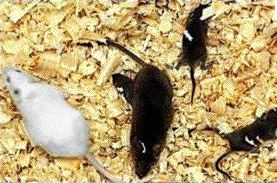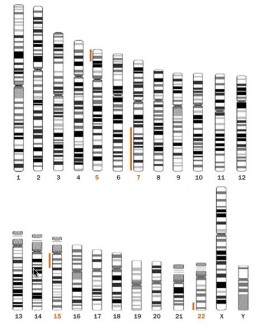 ADHD is an invisible disability that is largely non-psychiatric–though it has life-long psychological sequellae for those who grow up with it. As I noted in a blog entry November 21, 2010, evidence is growing that genetic factors are strongly involved in the complex syndrome we nowadays call Attention Deficit Hyperactivity Disorder (ADHD). Many genetic factors have been identified, and various clusters of these hereditary patterns can each cause the disability know by the common name, ADHD. See the November post for a break-out of heritability family studies. Very recently (May 17, 2011), the journal Nature Medicine published some important rat gene knock-out research by Won et al showing abnormalities of the GIT1 gene on chromosome 17 (exists in rats and humans) was significantly associated with specific ADHD patterns in humans: hyperactivity, difficulty with learning and memory, specific EEG patterns, physio-chemical abnormalities, and pharmacological responses to amphetamines and methylphenidate. Interestingly, the experimentally deficient mice “outgrew” their symptoms by age 7 months (human age, 30-40 years). This is in line with my observation that adults with ADHD tend to be less hyperactive, while maintaining the difficulties with inattention; I’ve often wondered if childhood “hyperactivity” manifests as restless anxiety as the brain matures.
ADHD is an invisible disability that is largely non-psychiatric–though it has life-long psychological sequellae for those who grow up with it. As I noted in a blog entry November 21, 2010, evidence is growing that genetic factors are strongly involved in the complex syndrome we nowadays call Attention Deficit Hyperactivity Disorder (ADHD). Many genetic factors have been identified, and various clusters of these hereditary patterns can each cause the disability know by the common name, ADHD. See the November post for a break-out of heritability family studies. Very recently (May 17, 2011), the journal Nature Medicine published some important rat gene knock-out research by Won et al showing abnormalities of the GIT1 gene on chromosome 17 (exists in rats and humans) was significantly associated with specific ADHD patterns in humans: hyperactivity, difficulty with learning and memory, specific EEG patterns, physio-chemical abnormalities, and pharmacological responses to amphetamines and methylphenidate. Interestingly, the experimentally deficient mice “outgrew” their symptoms by age 7 months (human age, 30-40 years). This is in line with my observation that adults with ADHD tend to be less hyperactive, while maintaining the difficulties with inattention; I’ve often wondered if childhood “hyperactivity” manifests as restless anxiety as the brain matures.
A brief comment on nomenclature: ADHD is the current term (Attention Deficit/Hyperactivity Disorder) in the current version of the psychiatric diagnostic manual and it covers both inattentive and hyperactive types of Attention Deficit Disorder, which in a former version was known as ADD. In the proposed upcoming revision, now being field tested (I will be one of those psychiatrists testing the new diagnostic manual), subtypes have been eliminated, age of onset is raised from 7 years old to “on or before age 12,” and the number of criteria required for diagnosis has been lowered for adults (The proposed change would account for recent findings that indicate a decline in symptoms as a patient ages. “Follow-up studies of children who had ADHD show that as they grow older they have fewer and fewer symptoms but they remain impaired,” said one of the developers of the new DSM-5).
…And recent studies of Autism show similar trends.
Some really good science writing showed up this week in response to a publication of three papers in the June 9 Neuron on specific genetic changes in autism. I commend Laura Sanders’ piece in Science News (June 8 web edition) . That link may not be available to non-subscribers, so I will offer highlights (I have deleted some phrases and added boldface emphasis). Below that, I have posted a round-up for psychiatrists from the American Psychiatric Association on genetic variability involved in the autism spectrum. For the backstory on the genetics of autism including the details of genetic variation, I have placed, at the bottom of this review, a succinct and valuable review by Laura Sanders from an upcoming Science News article.
New genetic data illustrate why researchers have struggled to find a single cause for the baffling suite of developmental and behavioral conditions, and may help point the way to a unifying process underlying them. The studies also begin to explain why autism spectrum disorders are more common in boys than girls.
Though the specific genetic changes identified account for only 5 to 8 percent of autism cases, what they reveal about the biology of autism may have much wider implications.
Two of the studies examined DNA samples taken from carefully screened families. Each family included two unaffected parents and one high-functioning child diagnosed with autism spectrum disorder. For most families, an unaffected sibling was also included. By studying genetic changes in unaffected family members, the researchers could find abnormalities that were not passed down from parents but arose spontaneously in the genomes of affected children.
“What was surprising is how unique each of the variants is,” says geneticist Huda Zoghbi of Baylor College of Medicine in Houston. “This really speaks to the immense heterogeneity of autism. We suspected it, but these data show it clearly.”
The results may also help explain why autism spectrum disorders are much more common in boys. Autism strikes four boys for every girl, yet girls’ DNA actually harbors more of these rare autism-associated genome duplications and deletions. And these genetic anomalies aren’t just more abundant in girls; they are also more severe. For a girl with autism, the median number of genes scrambled by duplication or wiped out by a deletion was 15.5, while for a boy with autism, the number was just two.
Through some mysterious process, girls are just more resistant than boys to the genetic causes of autism, the results suggest. “Overall, it does look like a girl can have the same genetic insult as a boy, but not be diagnosed with autism,” Wigler says.
The scientists can’t explain why girls might be more protected. Some researchers have proposed that sex hormones or some unidentified effects of genes on the X chromosome may play a role. Boys have only one copy of the X chromosome, so a genetic aberration there may be particularly dangerous for them.
_____________________________________________
Studies Cast Autism Disorders As Genetically Very Complex
The Los Angeles Times (6/9, Roan) reports, “Autism is not caused by one or two gene defects, but probably by hundreds of different mutations, many of which arise spontaneously, according to research that examined the genetic underpinnings of the disorder in more than 1,000 families.” The results of “three studies published Wednesday in the journal Neuron cast autism disorders as genetically very complex, involving many potential changes in DNA that may produce, essentially, different forms of autism.” Interestingly, the genes affected “appear to be part of a large network involved in controlling the development of synapses, the critical junctions between nerve cells that allow them to communicate, according to one of the three studies.”
A second analysis “identified at least 250 to 300 variations that appeared to be associated with the condition,” the Washington Post(6/8, Stein) “The Checkup” blog reported. “The mutations appeared much more likely to cause autism in males than in females.” Meanwhile, the third study discovered “an association between mutations and autism that, when deleted, also play a role in Williams syndrome, a rare developmental disorder. People with that condition tend to be highly social, sensitive and empathetic.”
HealthDay (6/8, Goodwin) reported, “Everyone carries a certain number of duplications or deletions of one or more sections of DNA, something known as copy number variants, explained Dr. Christian Schaaf, an assistant professor in the department of molecular and human genetics at the Baylor College of Medicine, who wrote an accompanying editorial.” He explained that if people “accumulate enough of them, and the duplications and deletions occur on certain important areas of the chromosomes, those variants may lead to autism and other conditions.” What’s more, two of the studies suggest that “girls may be more resistant to the spontaneous genetic mishaps that explain some cases of autism in families with no history of the disorder.”
WebMD (6/8, Doheny) reported, “Andy Shih, PhD, vice president of scientific affairs for Autism Speaks, an advocacy and research organization,” commented on the studies, saying that the results confirm that “it’s still impossible to explain the majority of cases of autism.” Shih pointed out that “sporadic mutations appear to play more of a role in families with just one child affected.” Over time, however, “the genetic findings could be useful information during genetic counseling in families who have one affected child, he says.”
____________________________________________________________
Backstory: The Genetic Puzzle By Laura Sanders
Science News June 18th, 2011; Vol.179 #13 (p. 5)
Autism spectrum disorders are highly heritable, but like many complex disorders they can’t be pinned to a single genetic flaw. Though many genetic changes have been associated with the disorder (the locations of some are shown here on the human chromosomes), each one accounts for only a small fraction of cases.
Science News June 18th, 2011; Vol.179 #13 (p. 5)
Autism spectrum disorders are highly heritable, but like many complex disorders they can’t be pinned to a single genetic flaw. Though many genetic changes have been associated with the disorder (the locations of some are shown here on the human chromosomes), each one accounts for only a small fraction of cases.
Chromosome 5
Several single-letter DNA changes at one end of chromosome 5 (orange line) have been associated with autism, but each of these variations appears to contribute only a very small amount to a person’s risk of developing autism.
Chromosome 7
By studying inheritance patterns in families with autistic members, scientists have found a region of chromosome 7 (orange line) that appears to be relevant to the condition. Genes that tell nerve cells how to hook up with each other as the brain grows are located here.
Chromosome 15
About 1 percent of people with autism have duplications of a stretch of chromosome 15 (orange line). Large-scale duplications, deletions and rearrangements in other parts of the genome have also been linked to autism.
Chromosome 22
Mutations in a gene at one end of chromosome 22 (orange line) that is involved in nerve cell communication, SHANK3, are linked to some cases of one nonverbal form of autism. These mutations seem to arise spontaneously rather than being inherited.

